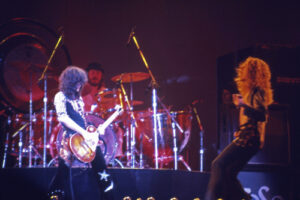
Feature Photo: Photo: By Don Hunstein (MTV) [Public domain], via Wikimedia Commons
Stevie played with unmatched intensity, weaving conviction, intricacy, complexity, delicacy, and explosive power into his performances, making it seem almost otherworldly that this human being walked among us. Like his idol Jimi Hendrix, Stevie had a presence that set him apart from mortals. Yet, while Hendrix’s style had a raw, unpolished grit, Stevie added a refined ruggedness that was uniquely his own.
Stevie’s beginnings as a musician started at a young age when he became inspired by his older brother, Jimmy Vaughan. He decided to teach himself guitar by playing along to the records of his other influences, which included Albert King, B.B. King, Freddie King, Muddy Waters, Albert Collins, Johnny “Guitar” Watson, Wes Montgomery, Django Reinhardt Chuck Berry, and Lonnie Mack. At the age of seventeen, he decided to make a career in music by playing in several different garage bands that were landing reasonable gigs in nightclubs and the works, until finally recruiting bassist Jack Newhouse and drummer Chris Layton for what would be his band, Double Trouble, named after an Otis Rush song. After a few years of gaining a reputation in the Texas club scene, they eventually landed a spot at the Montreux Jazz Festival, where they caught the eye of Jackson Browne and Mr. Bowie. The rest was certainly history in the making.
Even after the slight turn of unfortunate events involving alcoholism and drug abuse, Stevie managed to come out a better person and musician at that point; one would argue that his best work was during his sobriety. As soon as he got clean, he released his 1986 live album, Live Alive, and did extensive tours, including opening up for Robert Plant, the New Orleans Jazz & Heritage Festival, and European gigs, before recording his fourth record, In Step. By 1990, he recorded Family Style with his brother Jimmy, and by late 1990, he and Double Trouble were headlining tours throughout America; their East Troy, Wisconsin gig featured a famous encore jam with Clapton, Buddy Guy, his brother, and Robert Cray. But things took a tragic turn for the worse when, after the concert, Stevie boarded a helicopter that crashed on its way to Chicago; his life would be taken at the age of 35 years old.
Much like with all of the other greats who have died young, there’s no telling how far his talents could have soared. But we only have his indelible work to marvel over for many years. So here’s to one of the best blues guitarists of his time and one of the greatest to ever walk the Earth: Stevie Ray Vaughan!
# 10 – The House Is Rocking – In Step (1989)
“The House Is Rockin’” kicks off In Step, Stevie Ray Vaughan and Double Trouble’s final studio album released during Vaughan’s lifetime. Recorded between January 25 and March 13, 1989, at Kiva Studios in Memphis, Tennessee, with additional sessions at Sound Castle and Summa Studios in Los Angeles, California, this track encapsulates the band’s powerful energy and their deep-rooted connection to blues and rock. Produced by Vaughan alongside Jim Gaines, In Step marked a new chapter for the band—one shaped by both sobriety and a renewed creative spirit.
The lineup on “The House Is Rockin'” includes Vaughan on guitar and vocals, Tommy Shannon on bass guitar, Chris Layton on drums and percussion, and Reese Wynans on keyboards. Together, they create a raucous, no-holds-barred atmosphere that channels the raw power of a live performance. The song itself is a high-octane blues shuffle, driven by a propulsive rhythm section and Vaughan’s fiery guitar riffs. Its simplicity is deceptive; the band’s tight musicianship and Vaughan’s searing solos elevate it beyond a standard blues-rock number.
Lyrically, “The House Is Rockin’” is an invitation to a joyous, all-night party. Lines like “Kick off your shoes, start losin’ the blues” and “We got room on the floor, come on baby, shake somethin’ loose” emphasize a carefree spirit, while the repetition of the refrain—”Yeah, the house is a rockin’, don’t bother knockin'”—captures the sheer exuberance of the performance. The lyrics are straightforward, reflecting the band’s commitment to the roots of rock and roll, but they also carry an undercurrent of triumph. This is a celebration not just of music, but of life itself—a theme that resonates deeply given the context of Vaughan’s personal journey towards sobriety and his renewed sense of purpose during the recording of In Step.
While “The House Is Rockin’” did not chart as a single, it has remained a beloved track in Vaughan’s catalog and is often lauded for capturing the essence of his live shows. Comparisons can be drawn to other songs in his repertoire, such as “Pride and Joy” from Texas Flood, which similarly demonstrates Vaughan’s ability to fuse traditional blues with his own distinctive style. However, “The House Is Rockin'” carries an added layer of vitality and urgency, emblematic of Vaughan’s outlook in the final chapter of his career. It stands not just as a rollicking opener, but as a definitive statement of joy, resilience, and pure, unfiltered rock and roll spirit.
# 9 – Couldn’t Stand the Weather – Couldn’t Stand the Weather (1984)
“Couldn’t Stand the Weather,” the title track from Stevie Ray Vaughan and Double Trouble’s second studio album, captures the intensity and passion of a blues-rock legend in his prime. Recorded from January 17 to January 24, 1984, at the Power Station in New York City, the track embodies Vaughan’s masterful guitar work and his deep-rooted connection to the blues tradition. Produced by Richard Mullen and Stevie Ray Vaughan himself, the album represents a critical moment in Vaughan’s career, solidifying his standing as one of the leading guitarists of his generation.
On this track, Vaughan is joined by his Double Trouble bandmates: Tommy Shannon on bass and Chris Layton on drums. Jimmie Vaughan, Stevie Ray’s older brother, lends his talents on rhythm guitar for “Couldn’t Stand the Weather,” adding a textured, rhythmic drive that enhances the song’s dynamic interplay. It starts out with a feisty bass line and sneaky drum fill at an irregular measure before jumping straight into SRV’s funk-driven chords and his gravelly snarls. This song is also home to one of his very best guitar solos too; he tears into the meat of that middle progression with such animosity that his Albert King fanaticism awakes.
Lyrically, “Couldn’t Stand the Weather” explores themes of change and resilience against life’s trials. Vaughan sings, “Runnin’ through this business of life / Raisin’ sand if I’m needed to / Ain’t so funny when things ain’t feelin’ right / Then daddy’s hand helps to see me through.” His words paint a vivid picture of navigating life’s unpredictability, with love portrayed as the constant force that remains despite adversity: “Sweet as sugar, love won’t wash away / Rain or shine, it’s always here to stay.” The lyrics serve as a reminder that, while life’s challenges are inevitable, facing them head-on with strength and conviction is what truly matters.
Musically, “Couldn’t Stand the Weather” is a showcase of Vaughan’s unparalleled ability to blend blues with rock elements. The track features his signature heavy-handed Texas shuffle and a mesmerizing, improvised solo that highlights his technical prowess and emotional depth. As the song progresses, Vaughan’s guitar playing becomes more expressive, echoing the intensity of the approaching metaphorical storm. The lines “Changes come before we can go / Learn to see them before we’re too old” are delivered with a sense of urgency, mirroring the urgency in Vaughan’s playing.
Chart-wise, Couldn’t Stand the Weather performed strongly, reaching No. 31 on the Billboard 200. While it didn’t reach the commercial heights of “Pride and Joy” from Texas Flood, the song showcased a more mature and introspective side of Vaughan, who was not only reflecting on personal struggles but also capturing the essence of blues in its most authentic form. The song’s powerful groove and potent lyrics made it an instant fan favorite and a staple in Vaughan’s live performances, solidifying its place in the canon of essential blues-rock tracks.
In comparison to tracks like “Pride and Joy,” which radiates with jubilant affection, “Couldn’t Stand the Weather” takes on a more somber, contemplative tone. It reflects a different aspect of Vaughan’s artistry—one that isn’t just about the joy of playing but about capturing the emotional turbulence of life’s challenges. The song remains a testament to Vaughan’s ability to convey complex emotions through his music, making it a standout on an album filled with compelling compositions.
# 8 – Rude Mood – Texas Flood (1983)
“Rude Mood,” an instrumental track from Stevie Ray Vaughan and Double Trouble’s debut album Texas Flood, is a tour de force that perfectly encapsulates Vaughan’s virtuosic guitar skills and his ability to channel the energy of Texas blues. It’s a typical blues shuffle played at an impressive 264 beats per minute. It’s a pastiche of Lightin’ Hopkins’ song Hopkins’ Sky Hop, but it does an excellent job of throwing itself into a more swing-encouraged prance while still retaining the bulk of the song ‘s original riff. Released in 1983 and recorded at Jackson Browne’s Down Town Studio in Los Angeles over just three days in November 1982, this track is a frenetic, high-speed blues shuffle that stands out as one of the most electrifying moments on an already explosive album.
The core lineup on Texas Flood consisted of Stevie Ray Vaughan on guitar, Tommy Shannon on bass, and Chris Layton on drums, forming a trio that delivered a raw and powerful sound. With no additional musicians or overdubs, “Rude Mood” captures the essence of their tight, live-in-the-studio chemistry. The song showcases Vaughan’s mastery of the guitar in its purest form—his fingers dancing up and down the fretboard, bending strings with blistering precision and striking an intense balance between technical prowess and deep, emotional resonance.
“Rude Mood” takes its inspiration from the fast-paced, Texas blues tradition, evoking the frenetic energy of pioneers like Lightning Hopkins and Freddie King. Vaughan’s playing on this track is relentless, with a rapid-fire succession of hammer-ons, pull-offs, and bluesy double-stops that are both technically impressive and emotionally charged. The song’s structure is a blend of Chicago blues with a Texas shuffle twist, yet it feels fresh and invigorating, pushing the boundaries of what blues guitar could achieve in the early 1980s. It’s a high-octane workout that doesn’t just showcase Vaughan’s incredible speed and dexterity but also his deep understanding of blues phrasing and dynamics.
“Rude Mood” doesn’t boast lyrics—it doesn’t need them. The song’s narrative is told through Vaughan’s blistering guitar work. Every note seems to tell a story, from the opening riff that slashes like a knife to the cascading licks that tumble out of Vaughan’s Stratocaster like a torrent of emotion. The song stands as a stark contrast to the more melodic and lyrical “Pride and Joy,” another standout from Texas Flood. While “Pride and Joy” captured Vaughan’s playful side, “Rude Mood” is all about intensity—an unfiltered, straight-ahead blues jam that leaves no room for subtleties.
Critically, Texas Flood was a massive success, bringing Vaughan into the spotlight and earning a reputation as a blues revivalist who could hold his own among the genre’s greats. “Rude Mood” may not have charted as a single, but it quickly became a fan favorite and a staple of Vaughan’s live performances. The track received a Grammy nomination for Best Rock Instrumental Performance in 1984, further cementing its place in Vaughan’s legacy as a virtuoso.
# 7 – Little Wing – The Sky Is Crying (1991)
https://www.youtube.com/watch?v=An4uDegHB8s
# 6 – Life Without You – Soul To Soul (1985)
“Life Without You,” one of the most poignant tracks from Stevie Ray Vaughan’s 1985 Soul to Soul album, stands as a powerful testament to Vaughan’s soulful depth and emotional honesty. This track, recorded at the Dallas Sound Lab in Las Colinas, Texas, captures a period in Vaughan’s life marked by introspection and change. Released as the closing track on the album, “Life Without You” has since become a fan favorite, resonating deeply with audiences due to its heartfelt lyrics and the bluesman’s expressive guitar work.
Soul to Soul saw Vaughan embracing a more expansive sound palette, adding keyboardist Reese Wynans to his core trio with Chris Layton (drums) and Tommy Shannon (bass), creating a fuller, richer sonic landscape. “Life Without You” is built around a slow, deliberate blues progression, with Vaughan’s Stratocaster offering up mournful bends and weeping sustain that perfectly match the song’s contemplative lyrics. The recording captures Vaughan’s guitar tone at its most raw and emotional, a fitting tribute to the loved ones he had lost and a message to those he still held dear.
Lyrically, “Life Without You” touches on themes of loss, regret, and the necessity of love. It begins with Vaughan’s plaintive greeting, “Well, hello baby, tell me how have you been? We all have missed you and the way you grin,” setting a personal, conversational tone. As the song progresses, it becomes clear that Vaughan is not only addressing an absent loved one but also reflecting on his own life and struggles. The chorus, with lines like “Fly on, fly on, fly on my friend / Go on, live again, love again,” captures a universal longing for healing and redemption. Vaughan’s delivery is both tender and earnest, making the listener feel every ounce of pain and hope embedded in his words.
Musically, “Life Without You” is a slow-burning blues that showcases Vaughan’s mastery of dynamics and emotional expression. Unlike the faster tempo and fiery solos of “The House Is Rockin’” from the In Step album or the rhythmic groove of “Couldn’t Stand the Weather,” this song relies on a more restrained and introspective approach. Vaughan’s playing is deliberate, every note chosen carefully to convey the depth of his feelings. The solo section, in particular, is a highlight—his bends and vibrato are filled with aching vulnerability, echoing the reflective mood of the lyrics. The extended instrumental outro feels like a final, heartfelt farewell, his guitar singing what words alone could not express.
# 5 – Voodoo Child (A Slight Return) – Live Alive (1986)
“Voodoo Child (Slight Return)” is a song that Stevie Ray Vaughan made his own, even though it was originally written and recorded by Jimi Hendrix. Vaughan’s version of the song, which appears on his 1986 live album, Live Alive, is a stunning tribute to his idol and a testament to his own extraordinary talent. Recorded during various live performances in Texas, including shows at Austin’s Moody Theater and Dallas’s Dallas Starfest, Vaughan’s rendition captures the raw energy and virtuosity that made his live shows legendary.
On Live Alive, Vaughan unleashes a fierce interpretation of Hendrix’s classic, layering the song with his signature Texas blues sound. Joined by his band Double Trouble, consisting of Tommy Shannon on bass and Chris Layton on drums, Vaughan breathes new life into “Voodoo Child.” His aggressive guitar playing is matched by a rhythm section that provides a steady yet flexible backbone, allowing Vaughan the freedom to explore the full dynamic range of his instrument. His searing, extended guitar solos are packed with blistering speed, emotional depth, and technical precision, making this version stand out as one of the most electrifying performances of the song.
What sets Vaughan’s interpretation apart from Hendrix’s original is his unique fusion of blues, rock, and Texas swing. While Hendrix’s version on Electric Ladyland was psychedelic and experimental, Vaughan’s take leans heavily into a more straightforward blues-rock territory. His playing is sharp and unrelenting, each note dripping with intensity and passion. The famous wah-wah effects and the deeply bent notes that characterized Hendrix’s style are still present, but Vaughan imbues them with a distinct flavor, reflecting his own influences and the Austin blues scene from which he emerged.
Lyrically, “Voodoo Child (Slight Return)” is an invocation of mysticism and rebellion, themes that resonated deeply with both Hendrix and Vaughan. Lines like “Well, I stand up next to a mountain, and I chop it down with the edge of my hand” are delivered with raw conviction, echoing Vaughan’s reverence for Hendrix’s spirit while also staking his claim as a formidable guitar hero in his own right. The song is also a showcase for Vaughan’s mastery of improvisation. Each performance of “Voodoo Child” was different, a musical journey that took his audience to unexpected places. His interpretation of the lyrics often came with a vocal growl or a shout, adding a Southern grit to Hendrix’s original delivery.
“Voodoo Child (Slight Return)” became a staple of Vaughan’s live sets, and it remained a fan favorite throughout his career. Compared to other songs on the Live Alive album, like “Superstition” or “Texas Flood,” Vaughan’s rendition of “Voodoo Child” is a highlight because of its fiery intensity and emotional depth. It illustrates his ability to pay homage to his heroes while also pushing the boundaries of his own style. For many, it stands as one of the defining moments of Stevie Ray Vaughan’s live catalog—a song that showcases his unmatched ability to channel the spirits of blues and rock legends before him, while blazing his own trail as one of the greatest guitarists of all time.
# 4 – Tin Pan Alley – Couldn’t Stand the Weather (1984)
This nine minute jam from Couldn’t Stand the Weather is nothing short of dulcet magnitude. It’s atmosphere shrouds the senses in a darkly lit, smoke-filled bar reminiscent of Raymond Chandler noir, with some of the smoothest blues runs doused in the purest of tones. SRV doesn’t make it a point to be grandiose, instead he casually unfolds a story of the roughest place in town where violence, death, debauchery, and sex are the norm, and he yanks the listener by the scruff with his most ambitious song that almost sounds like it was improvised from the hip.
# 3 – Riviera Paradise – In Step (1989)
Stevie was a true master at his craft, a champion of every style of blues imaginable. His autodidact superiority of the guitar is truly a mind-bender because he understood its inner workings like any theoretically trained professional. Still, he blew those conventions out of the conversation with a more free-thinking dexterity. Riviera Paradise, his most beloved instrumental, demonstrates every element of his chops on a transcendental plane. This song showcased his penchant for musical diversity; this was him flirting seductively with jazz and easy listening.
Riviera Paradise was Stevie cleansing his soul of the personal demons that plagued him, metamorphosing him into a newly birthed animation who was now christened with the skill and humility to do even better things. Unfortunately, that couldn’t happen due to his death, but his everlasting existence still lives on through songs like this.









































